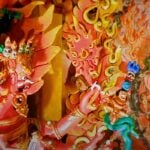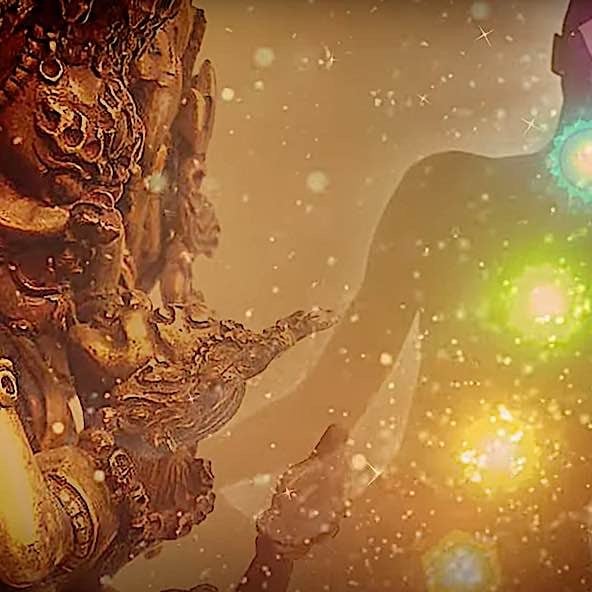Tara Principle: Wisdom, Compassion and Activity — the “practical” Karma Mother active in our daily, real-world lives
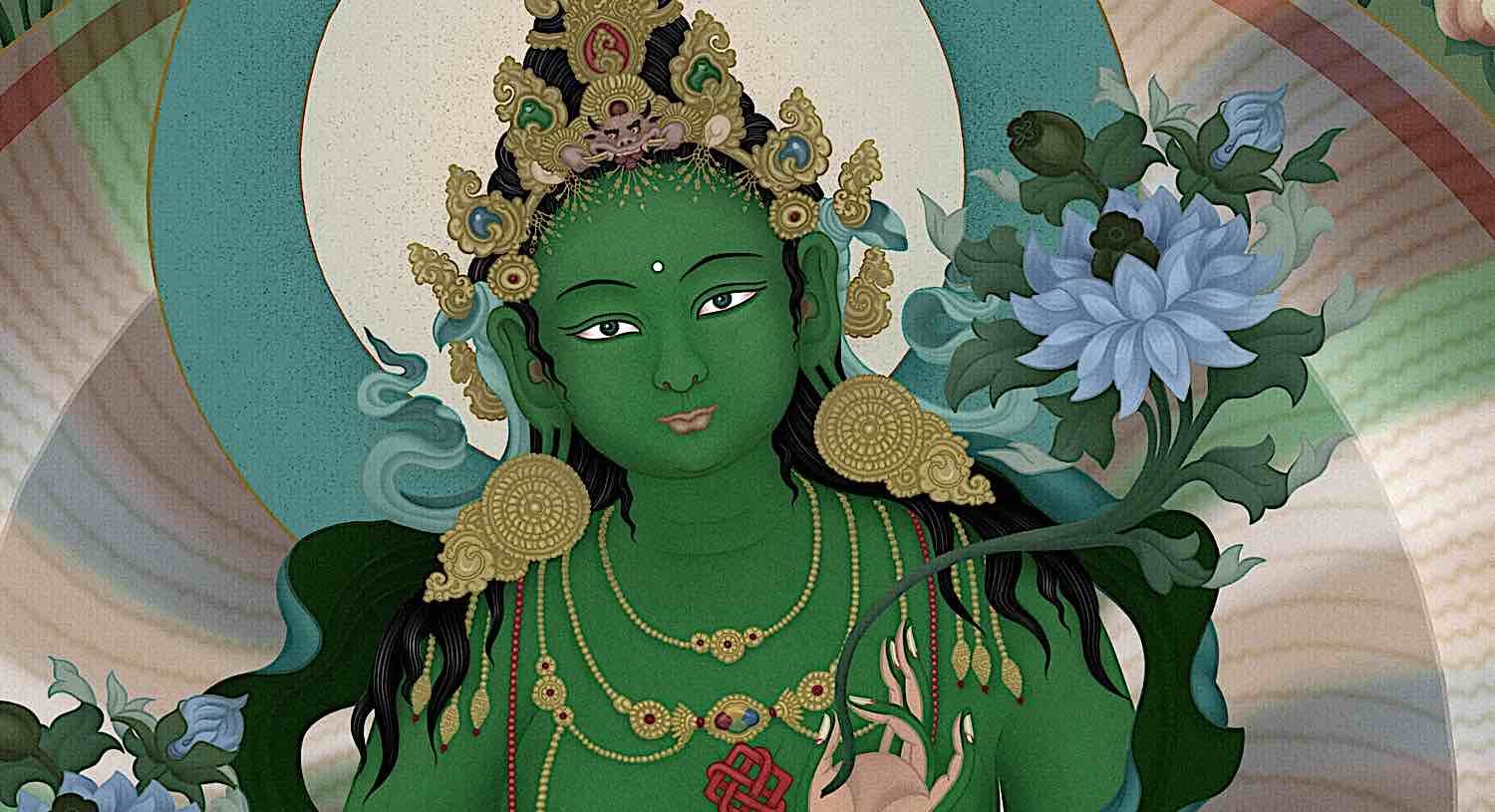
Why is Tara so beloved among Mahayana Buddhists? Why do we turn to Green Tara first, when we need help? Even an advanced yogi who practices a profound Yidam is likely to call out to Tara first in times of need, stress, or fear. It is easy to understand why. Why are the 21 forms of Tara?
Tara, like any Mother, is ready to jump to our aid, even in mundane areas of life. She is the “practical Buddha” — the “Karma Mother” — the Buddha most active in our lives. Her Sanskrit name translates as “a star by which to navigate” — and like a star, she is always with us whenever we look for her. How can we lose our way when her radiance never fades? At the same time, Tara is all we ever need even in our highest yoga practices.
White Tara’s beautiful life-affirming mantra helps enrich your health, life and practice:
This sentiment, this “nearness of Tara” — Tara as a mother, friend, protector, even highest yoga practice — is expressed in the Tibetan prayer by Lama Lobsang Tenpey Gyaltsen [2]:
“You are my guru, my yidam, my protector, my refuge, my food, my clothes, my possessions, and my friend. Since your divine quality is everything to me, let me spontaneously achieve all that I wish.”
Tara’s short Sutra transmitting her powerful Dharani, as taught by Tara herself in front of Shakyamuni Buddha, recited here with an introductory commentary:
How does Tara help?
Tara, as the savior Buddha leaps to the aid of anyone who seeks Her help, literally embodying “Karma” or activity.
How do we call on Her aid? Simply call Her name. How do we see Her face? Simply look up to any star (or close your eyes, or imagine her face), She is there. How do we find comfort in Her compassion? Simply know She is with you; like any mother, She never leaves you. She is the Mother, simultaneously the Wisdom of all the Buddhas, and their Compassionate Activity. The Tara Principle is all three: Wisdom, Compassion, Activity. What types of activity? All activities, from mundane to the highest Mahamudra or Dzogchen.
Calling Tara for help can be as simple as calling her name, or, ideally, chanting her mantra. Chant along with the Buddha Weekly band, the mantra of Karma Mother Tara:
How near Is Tara? Since all beings have Buddha Nature, at the ultimate level she is One with Us. There is an old Tibetan story about a man who complains to Tara that she “left him.” Her reply [3]:
“How could I ever leave who I am?”
Symbolizing and embodying this concept is Tara deity practice, where we visualize Tara in our own hearts. The heart is the location of “mind” in Tibetan Buddhism.
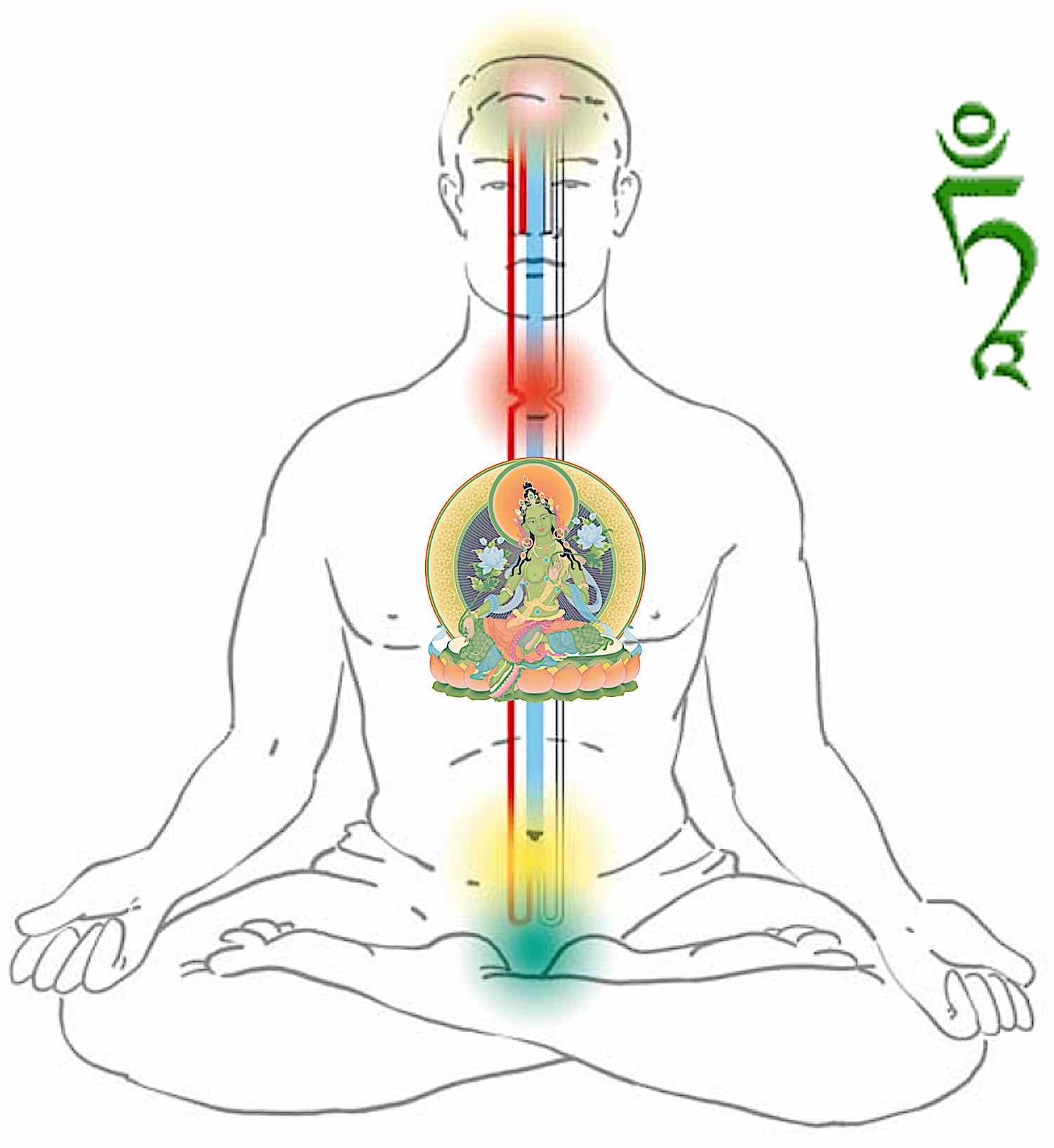
Tara the Karma Mother accessible to all
Tara embodies the practicality of action: wisdom and compassion in action. Dharma activity is as important as Dharma study — perhaps more so. The eightfold path, and most Dharma teachings, are about our karmic activities in our mundane lives. Understanding daily life to be a Dharma practice is critical to success for a Dharma practitioner.
Tara appears in 21 forms to show her helping Dharma activities manifest everywhere. The 21 Taras are all Tara, but she appears in different forms to express the red activities of magnetizing, the white activities of pacifying, the yellow activities of enriching and the blue or black activities of energetic enlightened wrath. One key practice of Tara is to praise her with her 21 praises daily. In Sanskrit it is profoundly beautiful, although you can chant in Tibetan, Chinese, English or any language. Here we chant in English:
Tara, the ideal Mother, is the Buddha most active in our world, embodying Dharma activity and Karma Yoga. Tara, the Mother, would do anything to help her children. To be near to us, she remains in our mundane world.

Tara nurtured and protected most of the great Mahasiddhas of India, and many of the great sages in Tibet. Alone in the wilderness, the great sages relied on her nurturing wisdom, compassion, and protective activity during long retreats. Her activity is no different for us. She is accessible and close to all practitioners. She is not a far-away Enlightened One who has passed into Nirvana. We might think of other Buddhas as we would a metaphorical Wise King, or some as Compassionate, loving Bodhisattva — but Tara is different.
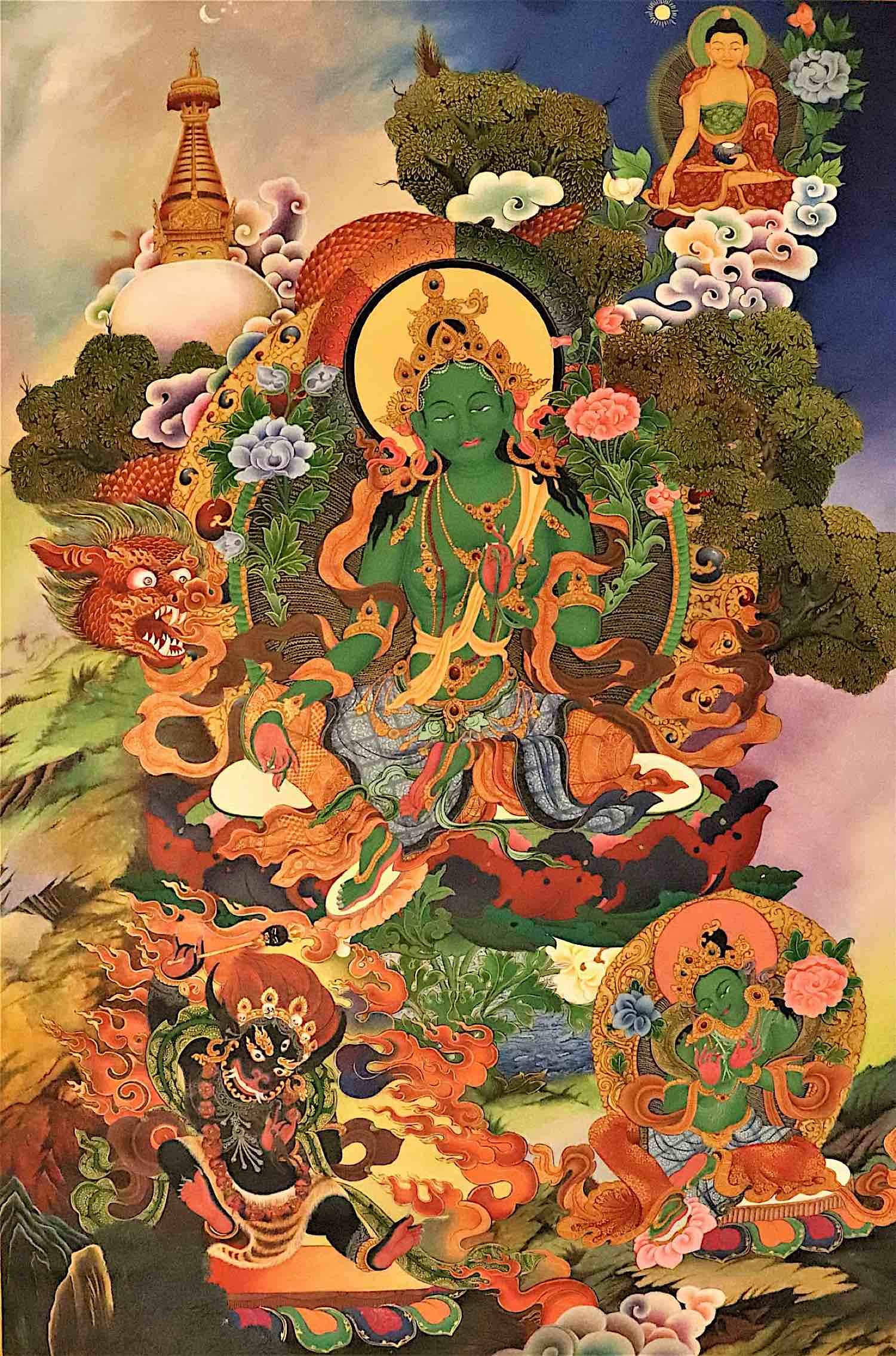
Tara, Mother of all Yogas
So, how does Tara, as the “Mother of all Buddhas” stand apart? She represents the “Activity of Wisdom and Compassion.” She is the Mother of All Buddhas — and also, therefore, the Mother of all Yogas — a Sanskrit term connoting the different practices:
- Jnana Yoga: Yoga of Knowledge of Wisdom
- Karuna Yoga: Yoga of Compassion
- Karma Yoga: Yoga of Activities
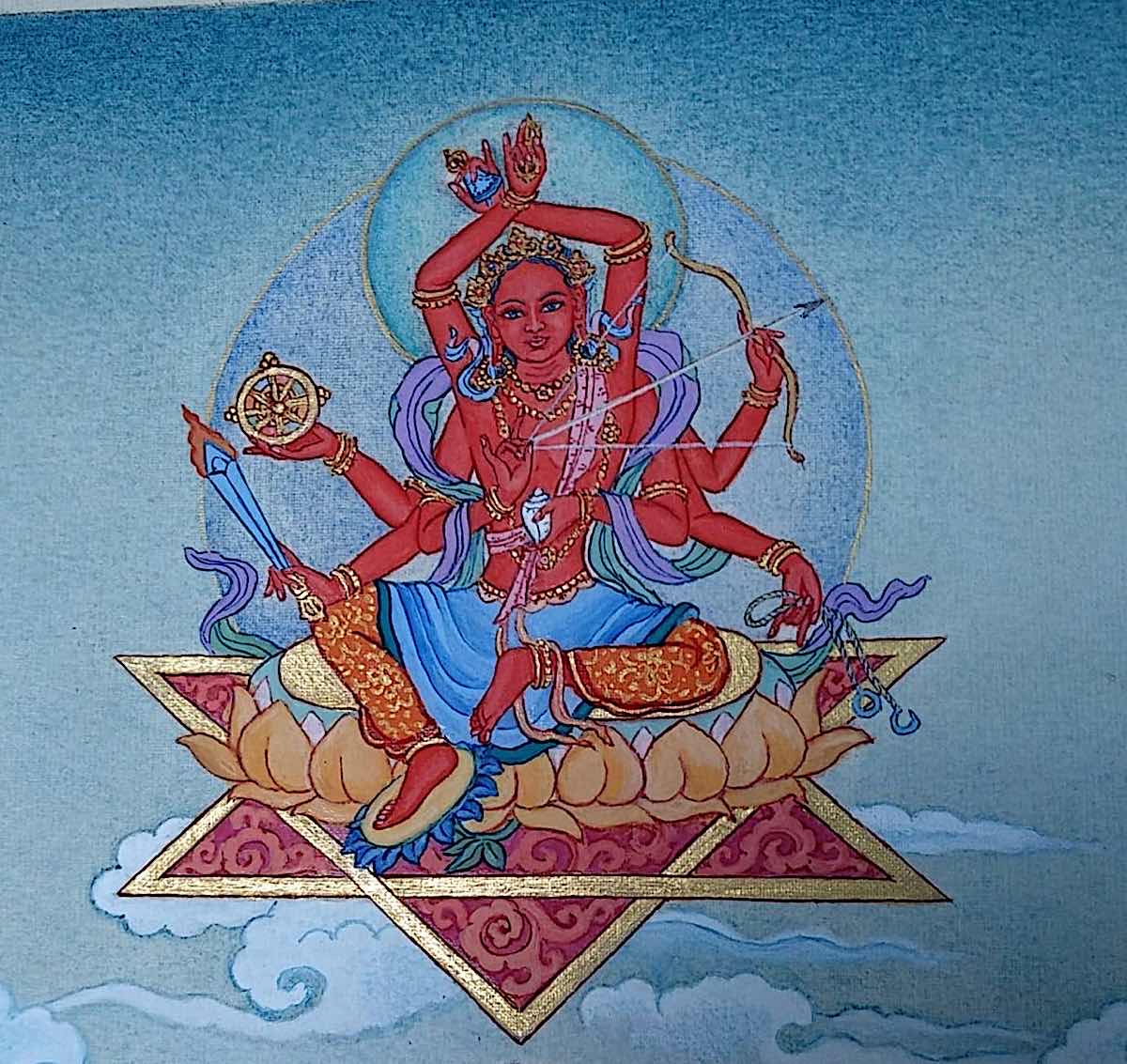
Enlightenment is a transformative process involving all three. Although we all have Buddha Nature, to reveal it, to attain full Enlightenment requires the three Yogas: Wisdom, Compassion and Activity.
The activities of Wisdom and Compassion — all three equally — lead ultimately to realizations and Enlightenment. For this reason, Tara, the “activity” principle of both wisdom and compassion, is considered the Mother of All Buddhas. She embodies all three in a very literal sense. She is also a Savior — a hero who jumps to the aid of all who call her name — literally activity.
Shakyamuni Buddha Relied on Tara
Even the great Conqueror Shakyamuni Buddha relied on Mother Tara’s “eight great laughters” to pacify fears, doubts, and demons. Tara is known as the Mother of All Buddhas because it is through Her Wisdom that all beings can attain Enlightenment. Traditionally, the Enlightened female represents “wisdom,” while the Enlighted male represents “compassion.” It is said, in many Tantras, that “all Buddhas relied on Tara.” [For more on Tara’s Eight Great Laughters, see the feature>>]
“The night preceding his awakening, while sitting under the Bodhi tree, Shakyamuni was attacked by a horde of demons attempting to divert him from his goal. At that moment, Tara appeared, and with eight great laughters made the demons fall to the ground and stopped them from doing harm. The Buddha then placed his mind in a state of perfect meditation and, at dawn, attained awakening. After that, he uttered the Tara Tantra.” — the great teacher Bokar Rinpoche, Tara The Feminine Divine
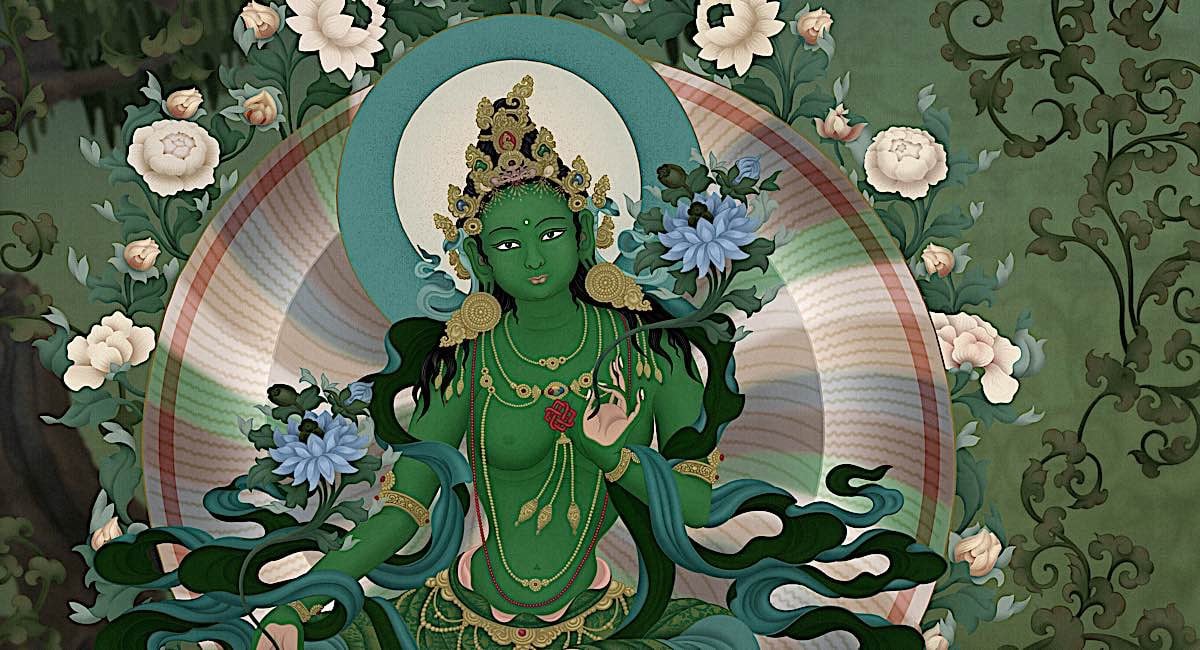
All levels of practice
Tara is also well-known as the “only deity practice anyone needs.” Whether we need a mundane protector, or a supermundane meditational path, Tara has countless forms, lineages and teachings for all needs and levels. At the mundane level, simply call her name to help save you from danger. On the other extreme, Tara’s Highest Yoga Practices are total paths including Generation Stage, Completion Stage, and even Body Mandala (inner body practices.)
During Chittamani Retreat teachings H.E. Zasep Rinpoche explained the concept of Tara teaching universally to all levels of student:
“Tara is everywhere. Tara is in the pure lands. Tara is here also. Why is Tara in the pure lands? Tara is in the pure lands to teach to the Bodhisattvas, the highly realized beings… Then, Tara comes down to us, many aspects of Tara — 21 Taras and so on — and there are other aspects of Tara, like Vajrayogini, Palden Lhamo, and so on and so on. Tara comes to us as deities, as Dharma protectors — so Tara is here, now.”
Tara’s Mantra for all
She also appeals to all needs and levels of practice. The Dalai Lama strongly recommended Tara’s mantra for help in this time of Pandemic. [Listen to the Dalai Lama chanting the Tara mantra below, or chant along.]
No initiation is needed to chant her mantra — even the most casual of admirers can benefit from her practice:
Om Tare Tuttare Ture Soha
Tara practice links:
- For a full story on Green Tara, including her 21 Praises, see>>
- For stories of Tara the Rescuer>>
- Tara’s Eight Laughters to Overcome Eight Dangers>>
- A complete section of features on Buddha Weekly>>
- Guided video meditation for Green Tara>>
- 21 Taras book excerpt from Tara in the Palm of Your Hand by H.E. Zasep Rinpoche>>
- White Tara for Healing and Long Life meditational video>>
- Tara in the Palm of Your Hand book on Amazon>>
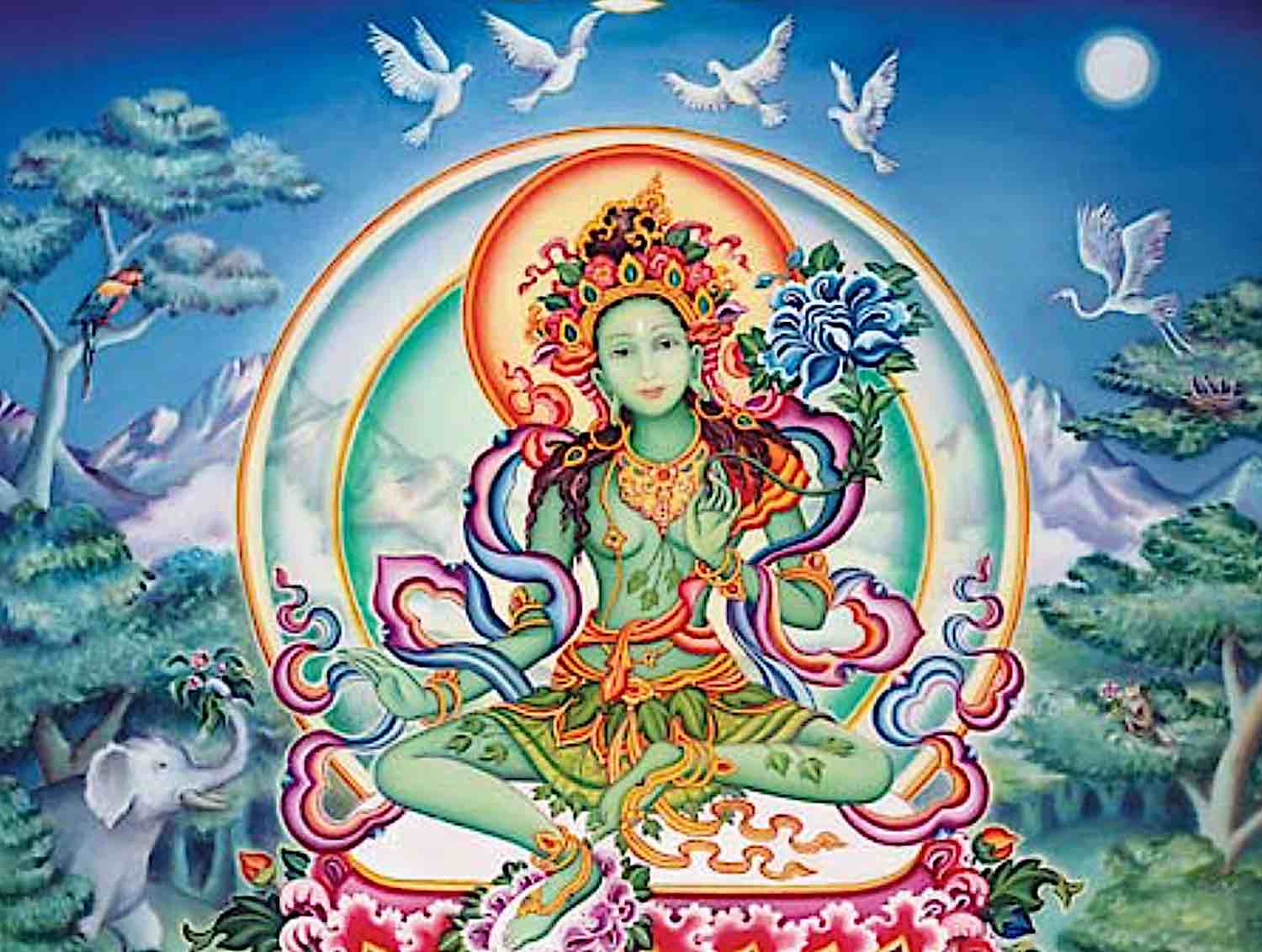
Tara: “transformation through activity”
“Transformation through activity” is another way to think of Tara. Tara, as a meditational and devotional deity is unique in that she combines Wisdom and Activity.
In Mahayana Buddhism — the Great Vehicle — we all aspire for the same end results: “Enlightenment for the sake of all beings.”
Lama Zangmo explains[1]:
“So anybody who approaches their spiritual path with the Tara principle, whoever we are, if we approach our practice with that atmosphere, with that principle of wanting to become Tara, because we have the potential, because we have the buddha nature, this is the way we enter the mandala of Tara’s activity. If our inspiration, commitment and courage are very strong, if we are focusing our attention wholeheartedly on this kind of action, then we become that type of being, gradually we increase those qualities.”

The Tara Principle: Wisdom, Compassion and Activity
The Tara Principle — wisdom, compassion, and activity in our world and in our lives — is what connects us to our potential for Enlightenment, our Buddha Nature in a practical way. The Tara Principle acknowledges that wisdom or compassion without activity in our daily lives is only theoretical. Tara is all about practical activity. It is through activity we can create practical, tangible results and realizations.
Her name, translated as “a star by which to navigate” already suggests Her boundless wisdom and compassion activity. Navigation is an activity that can prevent us from becoming lost (metaphorically: wisdom) and save us from harm (metaphorically: compassion.)
[Note: we capitalize Her and She in this feature to connote Her lofty status as Wisdom Mother.]
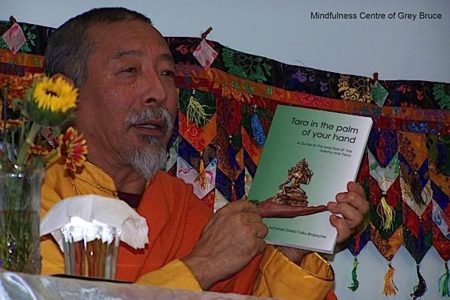
21 Taras: 21 activities
Why are there so many Taras? Not just 1, 8, 21, 157 — there are many manifestations of the beloved Enlightened Goddess? Why? Because she embodies all activities, and some practices identify each activity with a Tara. Dzongsar Rinpoche, in teaching “The Deity Principle,” explains[4]:
“So why then are there twenty-one of them? Actually, twenty-one is the most abbreviated form. There are so many, many, many Taras. There’s even a set of 100 million Taras and each has characteristics, there are details for each. The devotees of Tara, especially the devotees from great universities like as Nalanda, they go bananas. They long for her, they praise to her, they really supplicate, they beseech her.”
Tara’s best-known practice is the 21 Taras Praise, chanted daily around the world by millions of Buddhists. [For the entire 21 praises, see the end of this feature, or our previous in-depth series of three features on the 21 Taras, starting in this feature>>]
Each Tara represents a different “activity.” For example:
- The 20th Tara, Healing Parnashavari, is recommended as a practice by many teachers during the Covid-19 Pandemic — her specific activity is rescuing from epidemics and sickness. [For a feature on Healing Parnashavari, see>>]
- For “long life” activity, we think of White Tara. [See this feature on White Tara for in-depth practices and coverage>>]
Tara appears everywhere in our world — and even our inner world — as deities enthroned in our subtle inner bodies. In one practice, a Body Mandala of 157 Taras is enthroned at the chakras. (Body Mandala practice requires instruction, we mention it here as an example of the closeness of Tara’s activity.)

Tara, the Karma of all the Buddhas
Tara is the Enlightened Being who is most active and visible in our mundane world, even helping beings in ordinary activities. It is for this reason, Green Tara — who represents the Karma of All the Buddhas — is among the most beloved of deities. To practice Tara alone, is to practice all Buddhas. The well-known Tara practitioner Lama Lobsang Tenpey Gyaltsen (1852), who composed the beloved “Song of Longing for Tara, the Infallible” expressed this sentiment beautifully in his verse (translated to English by Lama Yeshe):
“I take refuge in you Tara; like you, no Buddha could ever deceive me. But understanding the odd character of these times, most Buddhas have gone into the bliss of nirvana. Even though they have great compassion, we have no connection. Since for me there are no other deities, you are my principal deity. Bestow realizations upon me, Divine Mother, essence of love. Arouse the great power of your compassion and think of me.” [Full Song of Longing at bottom of this feature, or see this commentary feature>>]
“No other deities” doesn’t imply exclusivity. It tells us that in our world, Tara is the most active. All Bodhisattvas put aside their ultimate Nirvana to help sentient beings, but Tara represents the most active form of this compassion and wisdom in our world.

What is Tara’s Activity?
Tara’s activity is the Eightfold Path. How does Green Tara save us? Through right conduct, right resolve, right effort, right speech. Famously, she protects from the eight great fears. These eight great fears are both “tangible” dangers in our mundane lives, as well as eight practice “fears” we all face in meditation and Dharma practice.
There are countless stories of her savior-rescuer-hero activities, but you don’t have to necessarily attribute her aid to supernatural miracles. She also helps us by helping us understand and live right view, right resolve, right speech, right conduct, right livelihood, right effort, right mindfulness, and right samadhi. [For stories of her many rescues from harm, see our previous feature>>]
Tara describes for us her activities in her Sutra, The Sutra of Tara Who Protects from the Eight Fears (Skt. tārā ṣṭaghoratāraṇī sūtra, Tib. སྒྲོལ་མ་འཇིགས་པ་བརྒྱད་འཇིགས་པ་བརྒྱད་ལས་སྐྱོབ་པའི་མདོ་, drolma jikpa gyé jikpa gyé lé kyobpé do, Wyl. sgrol ma ‘jigs pa brgyad las skyob pa’i mdo)
The eight dangers, in the opening of the Tara Sutra are:
“Protector from the eight dangers – Lions, elephants and fire,Serpents, robbers, water, plagues and demons [pisacas] – homage to You!”
These fears can certainly be taken as literal since protection is vital to our lives — and therefore our practice and our Mahayana mission — but they have a second layer of meaning. Lions can generally mean a wild animal. But it also means “pride.” Our own pride is the cause of many of our obstacles, the root of our ego issues. In commentaries, notably from the First Dalai Lama, the eight fears conquered by Tara are aligned with our internal obstacles:
- Lions represent “pride”
- Elephants stand for “ignorance”
- Fire is “anger” — one of the greatest obstacles to Dharma practice
- Serpents are “envy”
- Robbers are “wrong views” — the rob us of the opportunity to attain Enlightenment
- Water (often described as Floods) is “attachment”
- Plagues (disease) — in some Tantras it’s prison, but in the root Sutra it’s Plague or Epidemic — which stands for “avarice.”
- Demons (pisacas) [2] which is aligned with “doubt.”
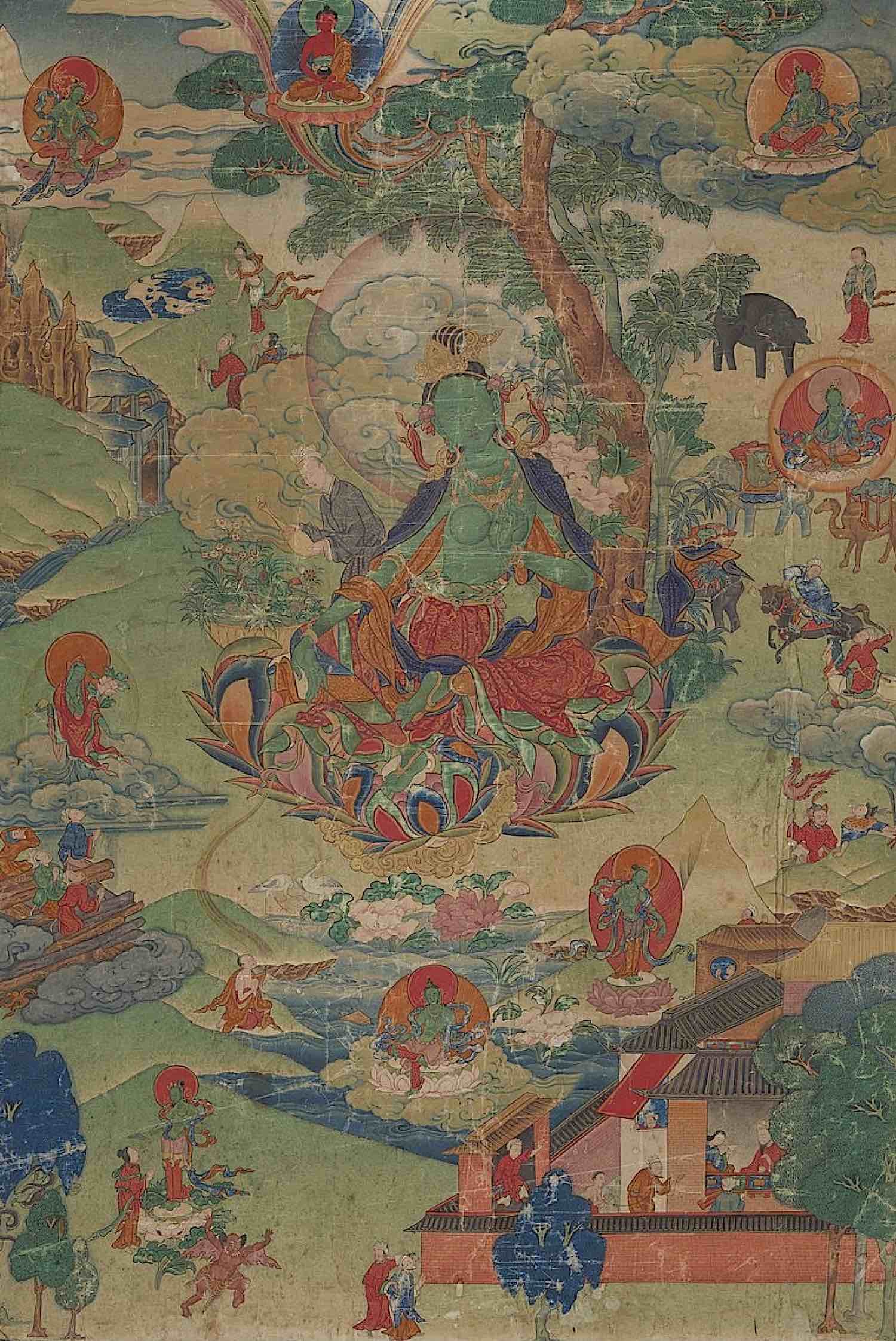
Tara embodies all the activity of wisdom and compassion
All Buddhas embody Wisdom and Compassion, and many might suggest an activity, but Tara equally represents all three. Tara’s principle suggests that study and wisdom alone are not sufficient. Through Her example, we understand that compassion and wisdom are embodied through activity.
In the Diamond Sutra, Buddha reminded us: ” Subhuti, equally incalculable is the merit of the Bodhisattva who practices charity without any attachment to appearances.” Practicing charity includes all three: activity of charity, compassionate giving, and the Wisdom of Emptiness.
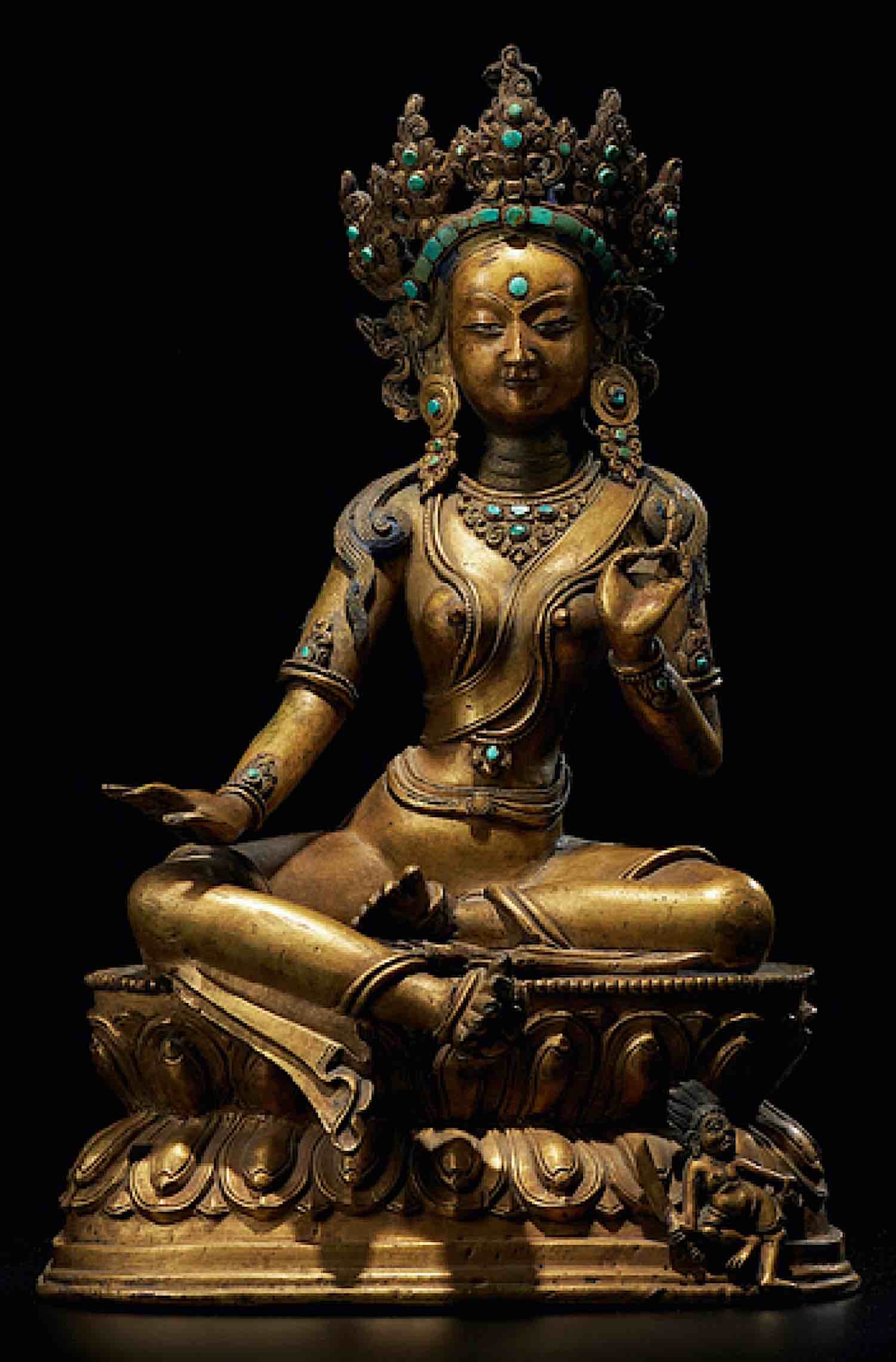
Eightfold Path
Buddha’s first teaching on the Eightfold Path focused on all three: right view, right resolve, right speech, right conduct, right livelihood, right effort, right mindfulness, and right samadhi. Right view, speech, conduct, livelihood and effort all strongly suggest activities — but, in fact all eight are activities. Staying in the present moment, mindfulness is an activity designed to help us develop insight (wisdom) and compassion.
All Buddhas are One, and all Buddhist practices involve both Wisdom and Compassion equally — the “two wings of Enlightenment.” All practices and teachings also involve various activities (the word Practice is another word for activity), but Tara embodies karma.
The Great Dharani of the Sutra of Tara
This Dharani from Tara’s Sutra is widely used in Buddhist practice:
OM NAMO ARYA-AVALOKITESVARAYA
BODHISATTVA
MAHASATTVA
MAHA- KARUNIKAYA
TADYATHA OM TARE TUTTARE TURE SARVA-DUSTAN
PRADUSTAN MAMA KRTE
DZAMBHAYA
STAMBHAYA
MOHAYA
BANDHAYA
HUM HUM HUM
PHAT PHAT PHAT SVAHA
MAMA ARYAVALOKABHAYA NARA
BODHISATTVA MAHASATTVANI
ADHISTHANA
ADHISTHITE MAMA SARVA-KARMA-AVARANA- SVAHBAVA
SUDDHE VISUDDHE
SHODHYAYA VISHODHAYA HUM PHAT SVAHA
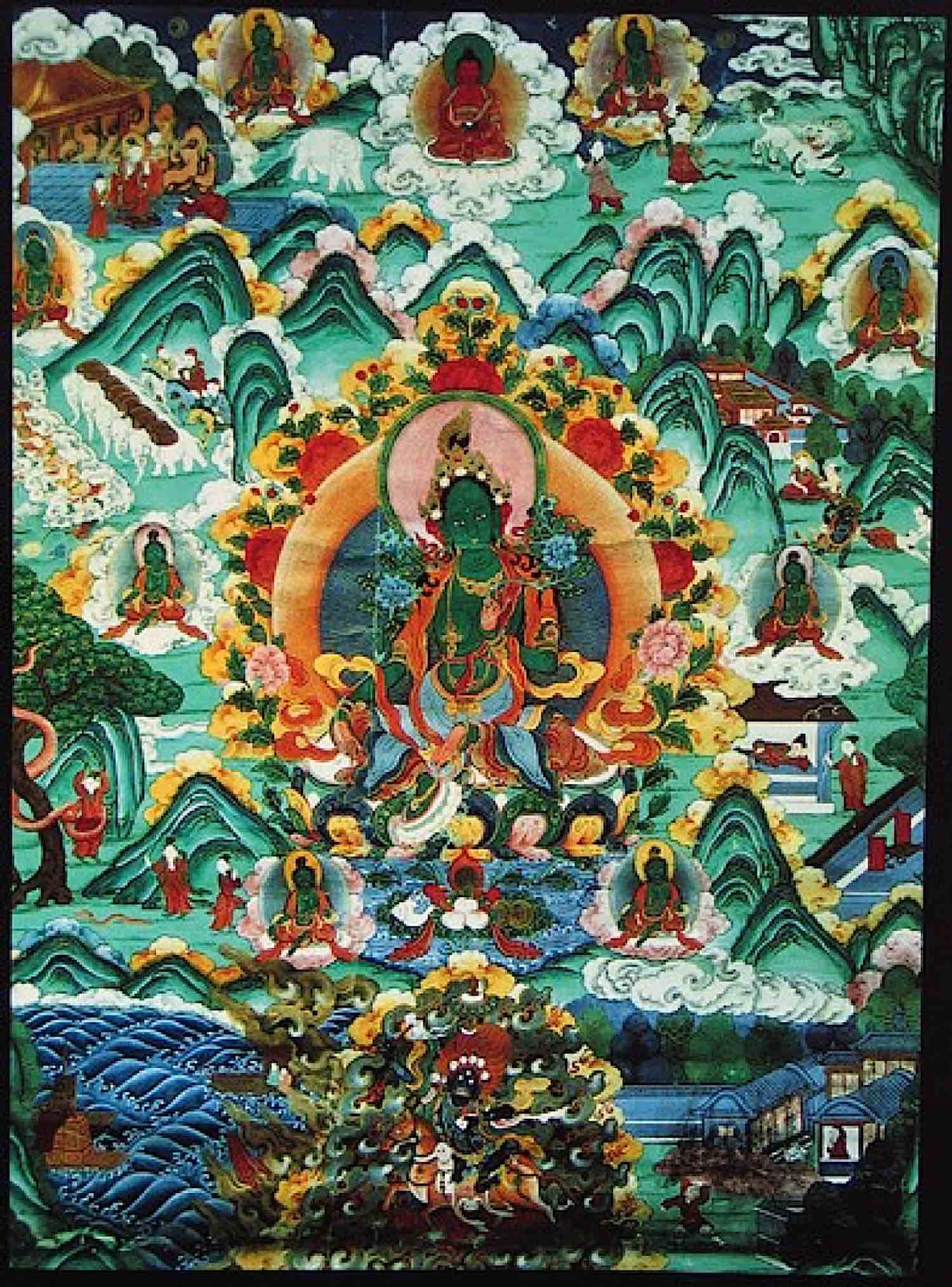
A Song of Longing for Tara, the Infallible
By Lama Lobsang Tenpey Gyaltsen (1852)
Translated by Lama Thubten Yeshe
From my heart I bow to Divine Mother Tara, essence of love and compassion, the most precious objects of refuge gathered into one. From now until I reach enlightenment, hook me with your great love and kindness to liberate me.
By the witness of the Three Jewels, not just from my mouth but from the depths of my innermost heart and bones, I pray to you morning and evening. Show your blissful face to me, Loving One. Grant me the nectar of your speech.
Great gurus and small gurus cheat us with their made-up teachings, selling Dharma, teaching without comprehension, not observing who is qualified and who is not, being concerned about their own happiness and the eight worldly concerns. Since I can no longer trust friends of this degenerate age, you are my principal guru. Inspire me, Divine Mother, essence of love. Arouse the great power of your compassion and think
of me.
I take refuge in you Tara; like you, no Buddha could ever deceive me. But understanding the odd character of these times, most Buddhas have gone into the bliss of nirvana. Even though they have great compassion, we have no connection. Since for me there are no other deities, you are my principal deity. Bestow realizations upon me, Divine Mother, essence of love. Arouse the great power of your compassion and think of me.
Most Dharma protectors do not show their powers. Tired of those who invoke them, they do not act. Other protectors, lacking insight but proud of their power, may be friendly for a while but will later do me harm. Since I cannot rely on other protectors, you are my principal protector. With divine action, Wisdom Mother, essence of love, arouse the great power of your compassion and think of me.
To ordinary view the names of objects are the same as their meaning. Like this, they produce afflictions and bind us to samsara. When it is time to die, unless I understand the true nature, could a wish-fulfilling gem enable me to carry even a sesame seed with me? Since I do not trust in illusions, you are my real richness. Please grant my desires, Divine Mother, essence of love. Arouse the great power of your compassion and think of me.
I cannot rely on the non-virtuous friends for even a day. They pretend to be close to me and all the while have in mind the opposite. They are friends when they wish it and enemies when they don’t. Since I cannot trust in this kind of friend, you are my best friend. Be close to me, Divine Mother, essence of love. Arouse the great power of your compassion and think of me.
You are my guru, my yidam, my protector, my refuge, my food, my clothes, my possessions, and my friend. Since your divine quality is everything to me, let me spontaneously achieve all that I wish.
Although I am overwhelmed by my habitual, uncontrolled mind, please cut these self-centered thoughts so I will be able to give my body and my life millions of times without difficulty to each sentient being. Inspire me to be able to develop this kind of compassion to benefit all.
Empower me to cut the root of samsara, self-grasping, and to understand the pure doctrine, the most difficult middle way, free from the errors of extremes.
Inspire me to practice as a bodhisattva, turning away from what is worldly, dedicating all my virtues to teaching living beings, never for even one instant thinking of just my own happiness. Let me wish to attain Buddhahood for the benefit of all.
Empower me to actualize as much as possible the most subtle vows and to keep them without a careless mind, thus becoming the most perfect bodhisattva.
Outwardly, let me be simple in my practice, while inwardly, actualize the depth of the diamond vehicle with the strong wish to practice the two stages. Inspire me to attain enlightenment quickly for the benefit of all.
Divine Wisdom Mother Tara, you know everything about my life — my ups and downs, my good and bad. Think lovingly of me, my only mother.
I give myself and all who trust in me to you, Divine Wisdom Mother Tara. Being completely open to you, let us be born in the highest pure land. Set me there quickly with no births in between.
May the hook of your compassion and your skillful means transform my mind into Dharma and transform the minds of all beings, whoever they are. They have all been my mother, the mother of one unable to follow the Conqueror’s teachings.
By reciting this prayer three times a day and by remembering the Divine Wisdom Mother Tara, may I and all beings who are connected to me reach whatever pure land we wish.
May the Three Jewels and especially the Divine Wisdom Mother, whose essence is compassion, hold me dear until I reach enlightenment. May I quickly conquer the four negative forces.
Om Tare Tuttare Ture Svaha!
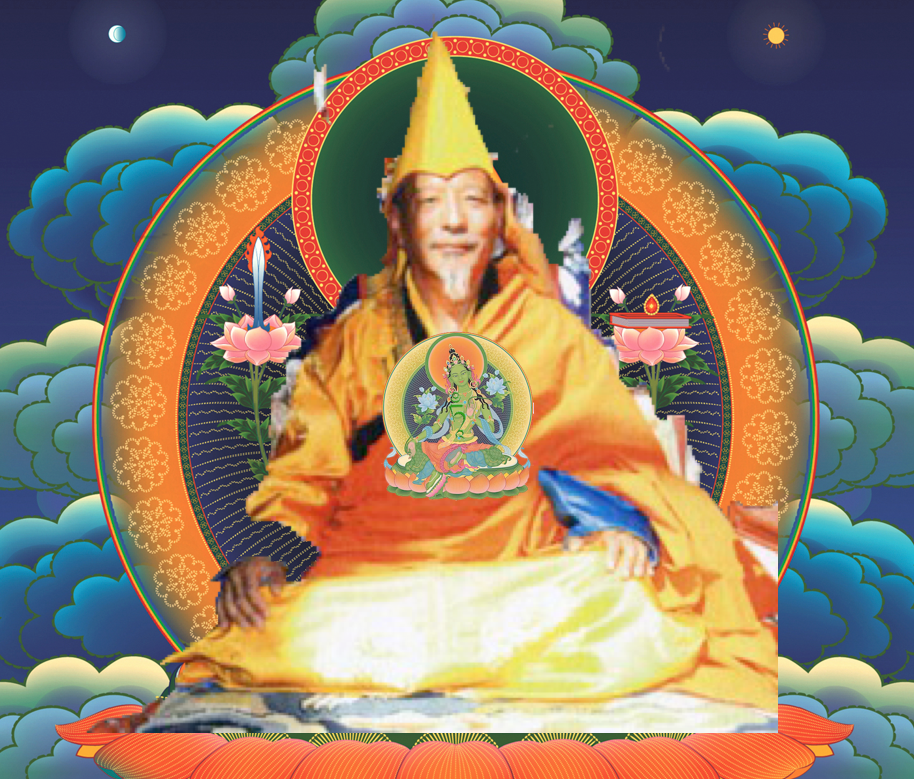
NOTES
[1] Benefits of Green Tara Practice, Lama Zangmo, Kagyu Samye Ling 2004>>
[3] Om Tare Tuttare Ture Soha website>>
[4] The Deity Principle and the Age of Tara, Dzongsar Rinpoche>>
More articles by this author

Who is my Enlightened Life Protector Based on Tibetan Animal Sign Zodiac in Buddhism? According to Mewa, Mahayana tradition and Kalachakra-based astrology (with Mantra Videos!)

4 Guardians of the World and Dharma: the Watchers of the World: the Four Heavenly Kings in Buddhism, Their Mantras and Practice
Search
Latest Features
Please support the "Spread the Dharma" mission as one of our heroic Dharma Supporting Members, or with a one-time donation.
Please Help Support the “Spread the Dharma” Mission!

Be a part of the noble mission as a supporting member or a patron, or a volunteer contributor of content.
The power of Dharma to help sentient beings, in part, lies in ensuring access to Buddha’s precious Dharma — the mission of Buddha Weekly. We can’t do it without you!
A non-profit association since 2007, Buddha Weekly published many feature articles, videos, and, podcasts. Please consider supporting the mission to preserve and “Spread the Dharma." Your support as either a patron or a supporting member helps defray the high costs of producing quality Dharma content. Thank you! Learn more here, or become one of our super karma heroes on Patreon.
Lee Kane
Author | Buddha Weekly
Lee Kane is the editor of Buddha Weekly, since 2007. His main focuses as a writer are mindfulness techniques, meditation, Dharma and Sutra commentaries, Buddhist practices, international perspectives and traditions, Vajrayana, Mahayana, Zen. He also covers various events.
Lee also contributes as a writer to various other online magazines and blogs.






